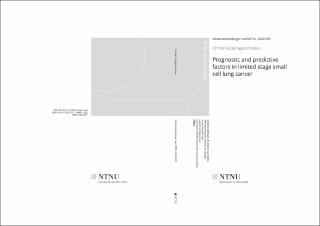| dc.contributor.advisor | Halvorsen, Tarje Onsøien | |
| dc.contributor.advisor | Grønberg, Bjørn Henning | |
| dc.contributor.author | Valan, Christine Damgaard | |
| dc.date.accessioned | 2020-09-01T08:39:10Z | |
| dc.date.available | 2020-09-01T08:39:10Z | |
| dc.date.issued | 2020 | |
| dc.identifier.isbn | 978-82-326-4755-2 | |
| dc.identifier.issn | 1503-8181 | |
| dc.identifier.uri | https://hdl.handle.net/11250/2675764 | |
| dc.description.abstract | Lung cancer is the most common type of cancer and the leading cause of cancer related deaths. Small cell lung cancer (SCLC) is one of two main types of lung cancer.
Concurrent chemoradiotherapy is recommended for SCLC if all lesions can be included in a radiotherapy field (i.e. limited stage, LS). Patients with more widespread disease are classified as having extensive stage (ES) and receive chemotherapy alone.
There are several definitions of LS, mainly differing in the extent of N3 involvement accepted. The International Association for the Study of Lung Cancer has recommended the use of the tumour, node and metastasis classification system since 2007, but still most studies only distinguish between LS and ES.
Despite high response rates (80-90%), the long-term survival for patients with LS SCLC is only 25- 30%. Concurrent chemoradiotherapy for LS SCLC is also associated with considerable toxicity. There is little knowledge regarding who will tolerate and benefit from therapy. Performance status is currently the only used prognostic factor in LS SCLC. Studies suggest that low skeletal muscle index (SMI) and muscle radiodensity (SMD) are associated with inferior survival and severe toxicity in several cancers, including lung cancer. However, in almost all studies of the role of muscle measures in cancer patients, only the baseline muscle measures have been assessed.
The overall aim for the project was to try to identify patients with LS SCLC who do not tolerate or benefit from concurrent chemoradiotherapy. We investigated different N3 involvement, baseline muscle measures and change in muscle measures during chemoradiotherapy.
Our project indicates that all N3 lymph node metastases should be considered LS, with the possible exception of those with involvement of two or more N3 regions. Patients with low baseline SMI and SMD or loss of SMI and SMD during chemoradiotherapy, should be considered for chemoradiotherapy on the same basis as other patients with LS SCLC. | en_US |
| dc.language.iso | eng | en_US |
| dc.publisher | NTNU | en_US |
| dc.relation.ispartofseries | Doctoral theses at NTNU;2020:203 | |
| dc.relation.haspart | Paper 1: Valan, Christine Damgaard; Slagsvold, Jens Erik; Halvorsen, Tarje Onsøien; Herje, Martin; Bremnes, Roy M.; Brunsvig, Paal Fr.; Brustugun, Odd Terje; Fløtten, Øystein; Levin, Nina; Sundstrøm, Stein Harald; Grønberg, Bjørn Henning. Survival in Limited Disease Small Cell Lung Cancer According to N3 Lymph Node Involvement. Anticancer Research 2018 ;Volum 38.(2) s. 871-876
https://doi.org/10.21873/anticanres.12296 | en_US |
| dc.relation.haspart | Paper 2: Grønberg, Bjørn Henning; Valan, Christine Damgaard; Halvorsen, Tarje Onsøien; Sjøblom, Bjørg; Jordhøy, Marit Slaaen. Associations between severe co-morbidity and muscle measures in advanced non-small cell lung cancer patients. Journal of Cachexia, Sarcopenia and Muscle 2019 s. 1-9
https://doi.org/10.1002/jcsm.12583
This is an open access article under the terms of the (CC BY-NC-ND 4.0) License https://creativecommons.org/licenses/by-nc-nd/4.0/ | en_US |
| dc.relation.haspart | Paper 3: Valan CD, Halvorsen TO et al. Changes in muscle measures during chemoradiotherapy in patients with limited stage small cell lung cancer | en_US |
| dc.title | Prognostic and predictive factors in limited disease small-cell lung cancer | en_US |
| dc.type | Doctoral thesis | en_US |
| dc.subject.nsi | VDP::Medical disciplines: 700::Health sciences: 800 | en_US |

